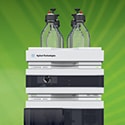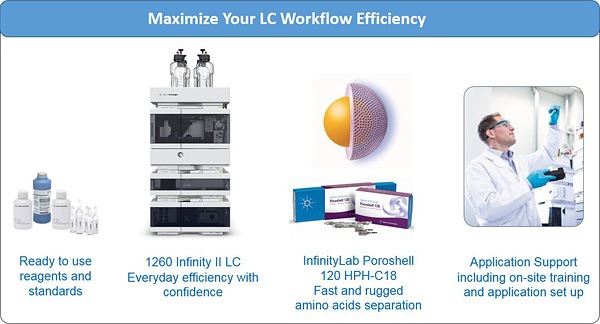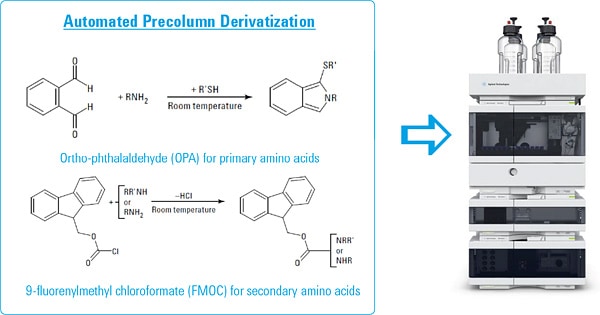Access Agilent eNewsletter October 2016

Agilent 1260 Infinity II solution delivers fast, sensitive, and automated amino acid analysis
Christian Gotenfels, Agilent LC Solution Manager

Figure 1. Complete one vendor solution (includes chemicals/standards, columns and application support) for fast, sensitive and automated amino acid analysis.

Figure 2. Automated derivatization in the 1260 Infinity II Vialsampler delivers reproducible reaction results and eliminates tedious manual procedures.
Amino acid analysis for protein characterization and cell culture media monitoring is an important application to the biopharmaceutical industry. In the food industry it is used for the nutritional analysis, fermentation process monitoring, and identification of the origin of the food product. To improve the workflow efficiency of these vital applications, the new Agilent 1260 Infinity II Amino Acid Analysis Solution (Figure 1) combines the advantages of the latest developments in LC instrumentation and column technology with proven precolumn derivatization chemistry.
Automated precolumn derivatization with new 1260 Infinity II Vialsampler
Amino acids are polar molecules and most of them do not absorb UV-Vis light significantly. In order to increase their hydrophobicity for the separation on a reversed column and to make them visible for UV and fluorescent detection, the amino acids need to be chemically derivatized prior to analysis. This derivatization step is automated by using the injector programming feature of the new Agilent 1260 Infinity II Vialsampler. During the online derivatization, first the primary amino acids react with ortho-phthalaldehyde (OPA) in the presence of 3-mercaptopropionic acid, then the secondary amino acids with 9-fluorenylmethyl chloroformate (FMOC). Compared to offline precolumn derivatization methods, this approach eliminates tedious manual procedures and reduces the risk of potential sources of errors due to operator skills or contaminations (Figure 2). In addition, the automation delivers reproducible reaction results.
InfinityLab Poroshell 120 HPH for fast, rugged amino acid separation at high pH

Figure 3. Fast separation of 21 amino acids (90 pmol/µL) and internal standards (norvaline and sacrosine) on the Agilent InfinityLab Poroshell HPH-C18 4.6 x 100 mm, 2.7 µm. Detection with 1260 Infinity II Fluorescence Detector Spectra.
The Agilent InfinityLab Poroshell 120 HPH-C18 columns are based on superficially porous particle (SPP) technology, consisting of a solid core (2.7 µm) and a superficially porous shell (0.5 µm). They provide the speed and resolution like sub-2 µm totally porous particles, but with 40 to 50% lower backpressure (Figure 3). Furthermore, due to 2 µm frit, they are as resistant to clogging as 3.5 and 5 µm columns. Since the amino acid separation is achieved with a phosphate buffer at pH 8.2, the surfaces of the Agilent InfinityLab Poroshell HPH-C18 particles are chemically modified to form an organic layer. This layer is resistant to silica dissolution in high pH conditions and achieves longer lifetimes under these separation conditions.
Sensitivity and flexibility in detection
By labeling the amino acids with OPA and FMOC reagent, both sensitivity and selectivity are improved in the detection. Since the primary and secondary amino acid derivatives have different wavelength absorbance maxima, the Agilent 1260 Infinity II Multi Wavelength Detector allows the simultaneous detection of both wavelengths without losing sensitivity. For more confidence, the Agilent 1260 Infinity II Diode Array Detector WR acquires additional spectral information for identification and peak purity analysis. The preferred detector for the amino acid analysis is the Agilent 1260 Infinity II Fluorescence Detector Spectra. As fluorescence is a rare phenomenon, this detector provides the highest selectivity for less matrix effects and delivers the highest sensitivity down in the femto-mol range.
The Agilent 1260 Infinity II can handle other (U)HPLC applications with easy method transfer
With a power range up to 600 bar and 5 mL/min the Agilent 1260 Infinity II Amino Acid Analysis Solution can also be used for other HPLC and UHPLC applications. For example, in Agilent publication 5991-6914EN, learn how established methods on Agilent 1100 Series Quaternary LC can be smoothly transferred to the Agilent 1260 Infinity II Amino Acid Solution. Even existing amino acid methods based on the totally porous ZORBAX Eclipse Plus C18 column can be easily transferred, since the Agilent InfinityLab Poroshell HPH-C18 has similar selectivity.
To discover more about the next generation Agilent 1260 Infinity II Amino Acid Solution, feel free to explore the brochure and informative solution page. Then contact your Agilent representative to take the next step for your busy lab.
Stay informed about the applications that are important to you
Subscribe to Access Agilent
Our free customized
monthly eNewsletter
Article Directory – October 2016
All articles in this issue
-
 Designed for true mobility—the 490-Mobile takes your lab to the sample
Designed for true mobility—the 490-Mobile takes your lab to the sample -
 Agilent 1260 Infinity II solution delivers fast, sensitive, and automated amino acid analysis
Agilent 1260 Infinity II solution delivers fast, sensitive, and automated amino acid analysis -
 Efficient analytical methods for catecholamines, metanephrines, and related metabolites in urine and plasma
Efficient analytical methods for catecholamines, metanephrines, and related metabolites in urine and plasma -
 Agilent IDP-3 Dry Scroll Pump provides clean, quiet, and reliable GC/MSD analysis
Agilent IDP-3 Dry Scroll Pump provides clean, quiet, and reliable GC/MSD analysis -
 Determination of chemical species in marine fuel oil by multidimensional GC/MS analysis
Determination of chemical species in marine fuel oil by multidimensional GC/MS analysis -
 Tip: Easily transfer Agilent GC/MSD methods to Agilent triple quadrupole GC/MS systems
Tip: Easily transfer Agilent GC/MSD methods to Agilent triple quadrupole GC/MS systems -
 Agilent ICP-QQQ provides unique solutions for nuclear applications
Agilent ICP-QQQ provides unique solutions for nuclear applications
Figure 1

Complete one vendor solution (includes chemicals/standards, columns and application support) for fast, sensitive and automated amino acid analysis.
Figure 2

Automated derivatization in the 1260 Infinity II Vialsampler delivers reproducible reaction results and eliminates tedious manual procedures.
Figure 3

Fast separation of 21 amino acids (90 pmol/µL) and internal standards (norvaline and sacrosine) on the Agilent InfinityLab Poroshell HPH-C18 4.6 x 100 mm, 2.7 µm. Detection with 1260 Infinity II Fluorescence Detector Spectra.